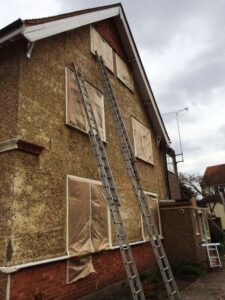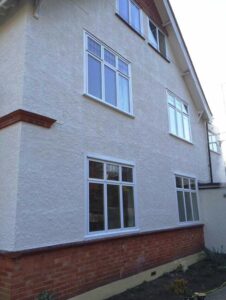Our UK paint website is well known for tips and advice about applying paint, but we felt that a tip or two about REMOVING paint would also add to the balance of things, so how do you remove paint?
Stripping paint and other unwanted wall coatings is usually the job that both DIY’ers and contractors loath and detest, but what goes on, must eventually come off, and paint or wallcoating stripping can’t be avoided!
Here are a few pointers to make the unbearable, a bit more bearable.
Removing a coating or a paint finish from a wall is awful, let’s face it, but it has to be done sometimes and is usually very hard work. In fact, in most cases, if it’s a professional job in the first place as opposed to a cowboy “lick of paint”, then ironically, the job can be 10 times as hard as removing a poorly applied paint finish! Luckily there are some tools available which should make the work of stripping paint much easier.
The first weapon in your arsenal should be a can of good chemical based paint stripper such as Nitromors™ or similar. Such products are very good for removing paint from woodwork however be very careful when you use it and always read the label on the can. Paint stripper can also strip skin, so be warned and yes I am being deadly serious.
When using a chemical paint stripper to remove old paint and get rid of old wall coatings, you will most certainly need to wear a good pair of thick protective gloves, do not use household washing up gloves such as marigold’s.
It is also essential, (see above), that you do not get paint stripper on your hands or any skin at all for that matter, so don’t wear sandals! Also make sure you are wearing long sleeves and your legs are also covered.
Protection of the face is also very important and always make sure that when stripping old paint using paint stripper, you make sure your eyes are covered with goggles, or glasses if no goggles are available.
I’ve protected myself, but what about protecting everything around me too?
 After making sure that you’ve protected yourself, which is essentially the main thing, you now need to look at your WORK AREA, i.e., the place, area or room where you are going to be doing the paint stripping.
After making sure that you’ve protected yourself, which is essentially the main thing, you now need to look at your WORK AREA, i.e., the place, area or room where you are going to be doing the paint stripping.
It’s good practice to spread dust sheets or at the very least, old newspaper, on the floor, or if paint stripping inside, any bits of furniture and such like.
It’s also extremely important to keep all pets and children WELL AWAY from anywhere where paint stripping is likely to take place. If that’s impossible, then quite simply, don’t do it, the risk is not worth it.
Now I have protected everything, it’s time I started to strip! (the paint that is…)
Start with an old paint brush, (and don’t use an expensive one), and apply a generous coating of paint stripper to the area where you want to remove the paint. Then leave for a while according the instructions on the tin.
Then, using a paint stripper, knife or shave hook tool, scrape the paint off, which should have by now reacted with the paint stripper and will be soft and easy to remove. If you are stripping exterior wall coating off an external wall, it may require longer than it says on the tin for the stripper to break the coating down. Do not use a powerwasher to remove the paint if you are also using a paint stripper.
When all the paint has been removed from the affected area, clean the wood or other surface with either cold water or paint thinners; this will have the effect of neutralizing the chemicals left behind by the stripper.
“I’m male and therefore love gadgets, (!), what about an electric paint stripper?”
This is a handy tool that is essentially a paint scraper with an integrated heating element. The element heats up when switched on, and when you hold the tool a certain distance from the paint, it softens it up and makes it easier to remove the paint or coating. This tool is usually best to remove paint from SMALL areas and stubborn paint that won’t come off using the methods we talked about above.
“OK, well how about if I use a blowtorch if I am stripping wood?”
When all else fails and you just can’t seem to get rid of that old paint, then this is when you should maybe consider using a blow torch instead, although extreme caution is needed when using one, especially of the potential fire risk and burn hazards associated with using this tool.
If you haven’t used one before, its best to forget this bit and call a builder or decorator instead! It also goes with out saying that a blow torch should never ever be used near anything flammable. When using one, you have to keep moving the torch or you may burn the surface beneath, or at worst, set it alight. In addition watch out for burning pieces of paint falling on the floor & these need to be put out quickly for obvious reasons.
A blow torch is often best to remove stubborn paint right down to the wood.
Start at the bottom and work your way upward, applying heat by moving the flame across the paint until it blisters and softens in a small area. Then remove the flame, scrape away the softened paint with a stripper knife.
When the job is done, and all the paint has gone, try finishing the area by sanding it down with a light sandpaper. Then once you have wiped all the dust off, if you are repainting it, leave it for a day, then paint a wood primer on it, then an undercoat and then your new topcoat.
External paint stripping
 If you are removing paint from the exterior walls of your house, there are also several methods you can use.
If you are removing paint from the exterior walls of your house, there are also several methods you can use.
Most exterior paint is more hard wearing than interior paint as of course external paints and coatings need to stand up to the weather, as opposed to interior paint which of course do not. Chemical paint stripper can be used externally, especially for getting rid of old and unwanted exterior wallcoatings past their sell by date (usually 15 years old coatings +).
I have to stress again, keep pets and children away. Also when stripping outside using the chemical process, don’t get paint stripper on floors or other surfaces, remember this is an ACID and will burn whatever it touches…….
There are also mechanical tools you can use for the outside, although sometimes when you get to this stage its often best to call a builder or a textured coating company in to do this for you as, especially if you have a big house or the walls are very high, there are far more risks involved that paint stripping inside.
These tools also can be expensive so it’s often best to hire them, whereby the plant hire company will often offer free training in how to use their tools safely, an offer which you should NOT turn down.
The tools often used outside for stripping old paint or exterior wallcoatings are:
- A Powerwasher
- Shot blasting or sand blasting
- A needle gun
- Wire bristle brush
Shot blasting will normally need to be done by a professional company due to the tools and equipment required, plus bear in mind the condition of the wall behind the paint as shot blasting is a heavy duty removal process!
This is also true with using tools such as needle gun. When stripping paint or wallcoatings from an exterior wall, make sure a wide area of the ground is protected as often the small chunks of paint will fly everywhere: the street, flower beds, lawns, the neighbors house etc. When using a wire brush, it’s best to note that this is for small areas, you wont be able to strip the paint from a whole house with a wire brush so don’t even try!
When using a power washer it is also a very good idea to wear weatherproof clothing as you will most certainly get drenched.
It goes without saying that stripping paint is not the best job in the world, but use the right tools, work safely and think about what you are doing and you should have no problems at all but if you are not sure or have no experience of the above, its usually best to call the experts in! It is also worth noting that good preparation of a wall surface, such as stripping paint, is a good starting point to prepare the wall for repainting so THINK about what will be going back onto the wall afterwards………..
About Author:
Why choose “Never Paint Again”?
Since 1986, we have extensive experience in repairing and painting all types of houses, in every corner of the UK and we are confident that we can help you too. We offer home improvement services across England and Wales.

